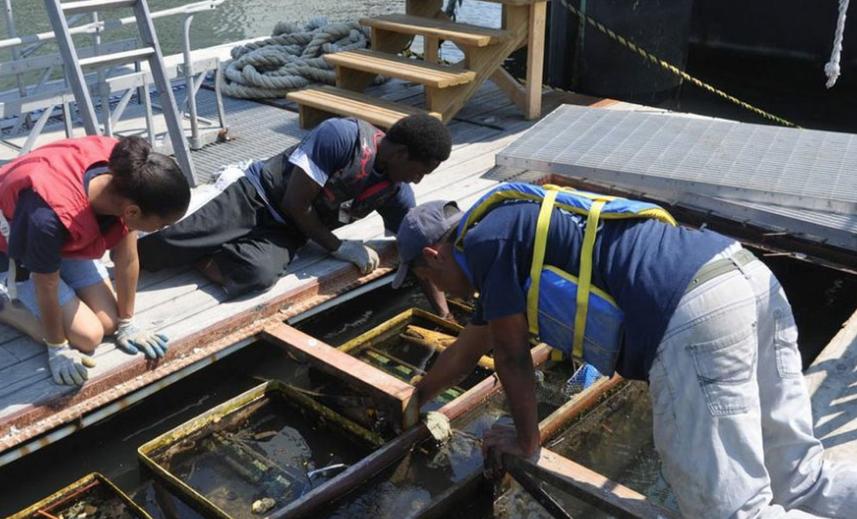A partnership of more than 20 organizations, businesses, nonprofits, and educational institutions has established a bold new goal of adding 10 billion new oysters to the Chesapeake Bay by 2025. The result will be cleaner water and creation of jobs that will help local economies.
“Oysters are so much more than the tasty bivalves that many know them to be. They are a crucial part of our ocean planet,” said John Racanelli, National Aquarium chief executive officer. “They help keep our waterways clean by removing harmful pollutants and they provide a hospitable place for other animals to live—from the backwaters of the Chesapeake Bay to the vast Atlantic Ocean. We’re proud to collaborate with the Chesapeake 10 Billion Oyster Partnership to revitalize the national treasure that is the Chesapeake Bay.”
The 10 billion oysters will come from a combination of expanded restoration activities. fishery repletion activities, and the continued growth of the Bay’s oyster aquaculture industry.
In recent years, the pace and scale of oyster restoration has been greatly accelerated by state and federal agencies’ efforts, including the National Oceanic and Atmospheric Administration, the Army Corps of Engineers, the Virginia Marine Resources Commission, and Maryland Department of Natural Resources, working with groups including the Oyster Recovery Partnership to implement the Chesapeake Bay Program goal of restoring 10 Bay tributaries by 2025.
The partnership has established as its top three priorities ensuring robust funding for oyster restoration, establishing sound science-based management that ensures sustainable harvest of the Bay’s oyster population, and expanding the oyster aquaculture industries in Maryland and Virginia.
“Scientists have been doing research on oysters in the Chesapeake for almost 150 years. The evidence continues to grow about the importance of abundant oyster populations for water quality, biological productivity and diversity, shoreline integrity and the resilience of this great ecosystem,” said Don Boesch, University of Maryland Center for Environmental Science Professor and President Emeritus. “Oyster reef restoration efforts over the past five years have been very successful in producing dense populations that are surviving, reproducing and adding greatly to the supply of oyster larvae in the Bay.”
Oyster aquaculture provides many of the same environmental benefits as wild oysters, including filtering algae and sediment as they grow to market size. Industry partners also note that aquaculture’s continued growth will create jobs and provide economic benefits to coastal communities.
“As a waterman and oyster farming entrepreneur, I’ve witnessed the power and potential for aquaculture to transform a disappearing economy into a thriving industry that will play a substantial role in achieving our 10 Billion goal,” said Johnny Shockley, Founding Partner, Hoopers Island Oyster Co. “This partnership promotes small business, creates jobs and maintains oyster growers’ long-term viability. We see a future when the Chesapeake once again leads the world in seafood production with hundreds of oyster farms and a sustainable public fishery that preserves our heritage and builds a billion-dollar industry.”
The 10 billion oyster goal relies heavily on commitments that Maryland and Virginia made to restore oyster populations in five tributaries in each state by 2025. As the partnership creates new volunteer restoration opportunities, it will also provide new voices in support of state and federal efforts to restore oyster populations.
Local and regional organizations play a critical role as well. Lynnhaven River NOW has a comprehensive approach to restoring the Lynnhaven. They educate, advocate to reduce polluted runoff, and they are actively restoring the river’s oyster population.
“In many ways bringing back the Lynnhaven oyster has defined the work of our organization,” said Karen Forget, Executive Director of Lynnhaven NOW. “Our work in reducing pollutants entering the river is measured by the areas open to shellfish harvest and those areas have grown from 1% in 2002 to 46% in 2018.”
The Lafayette River is a prime example of what partners can achieve when they work together. The use of reef balls, as well as reefs seeded with oysters grown by oyster gardeners, has the Lafayette on track to be the first river in Virginia with a restored oyster population.
“We will never achieve a restored and healthy Bay until we restore the Bay’s oysters,” CBF President William C. Baker said. “This partnership will help make that happen.”
More information on the partnership can be found at www.TenBillionOysters.org
National partners include Restore America’s Estuaries, Building Conservation Trust, and the National Aquarium.
In Maryland the partnership includes CBF, Coastal Conservation Association Maryland, the Downtown Sailing Center, Friends of St. Clements Bay, Friends of the Wicomico River, Harris Creek Oyster Company, Hoopers Island Oyster Company, Lighthouse Point Marina, the Living Classrooms Foundation, Mudgies Oyster Farm, Orchard Point Oyster Company, the South River Federation, The Great Baltimore Oyster Partnership, the University of Maryland Extension, War Horse Cities, Washington College, and the West-Rhode Riverkeeper.
In Virginia, the partnership includes Chessie Seafood, the Elizabeth River Project, Lynnhaven River NOW, Pleasure House Oysters, and Virginia Wesleyan University.
Scientific advisors to the partnership include the University of Maryland Center for Environmental Science, the Smithsonian Environmental Research Center, and the Virginia Institute of Marine Science.



Write a Letter to the Editor on this Article
We encourage readers to offer their point of view on this article by submitting the following form. Editing is sometimes necessary and is done at the discretion of the editorial staff.